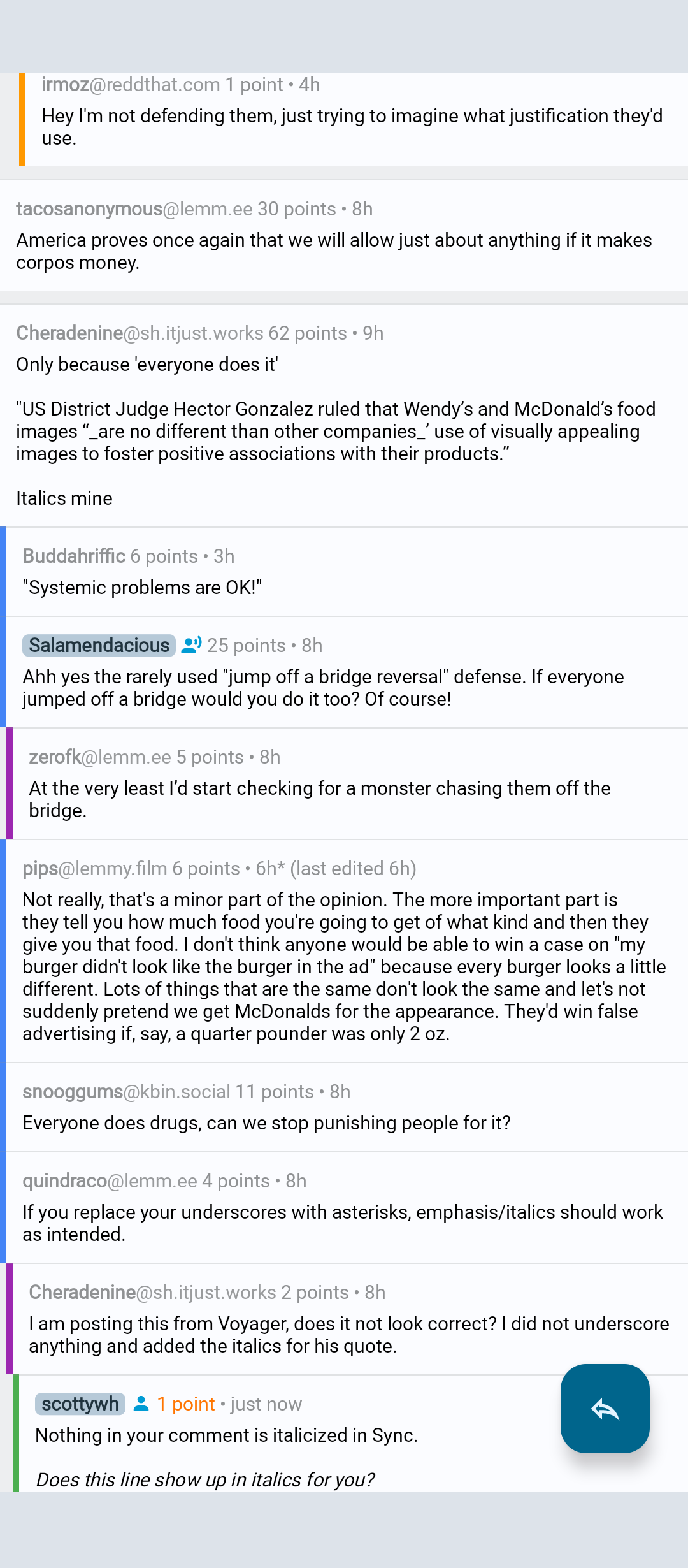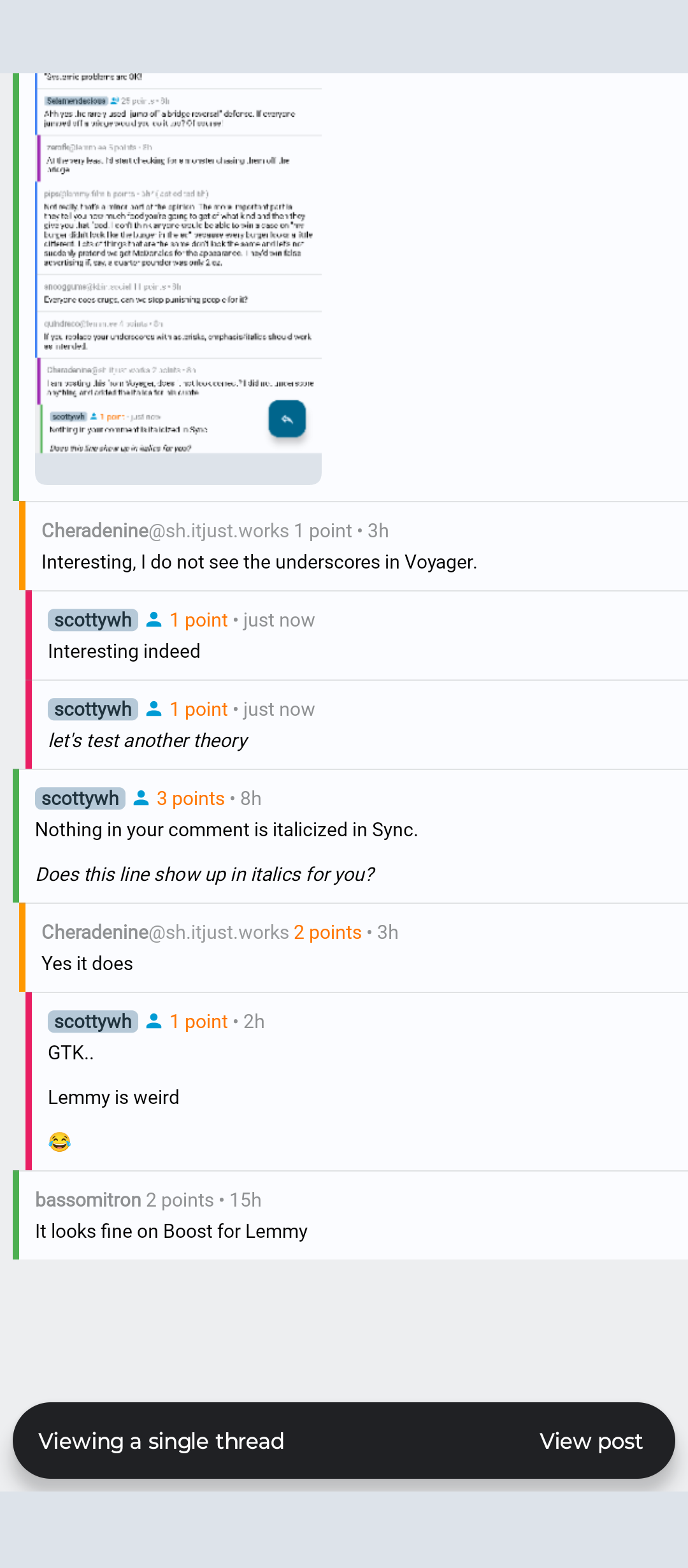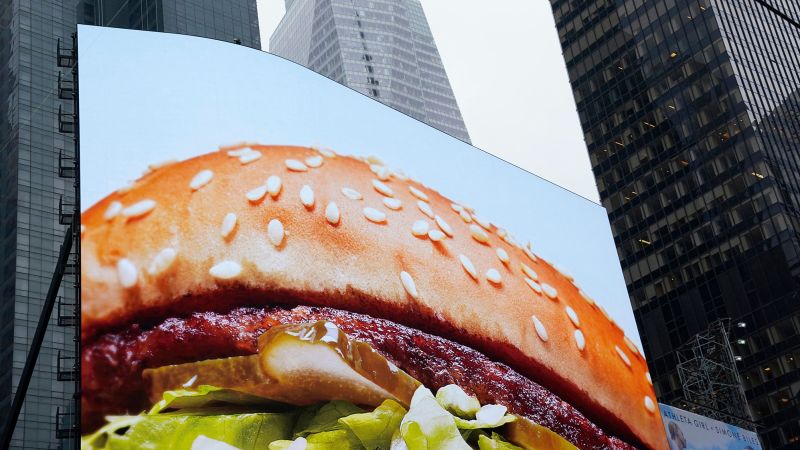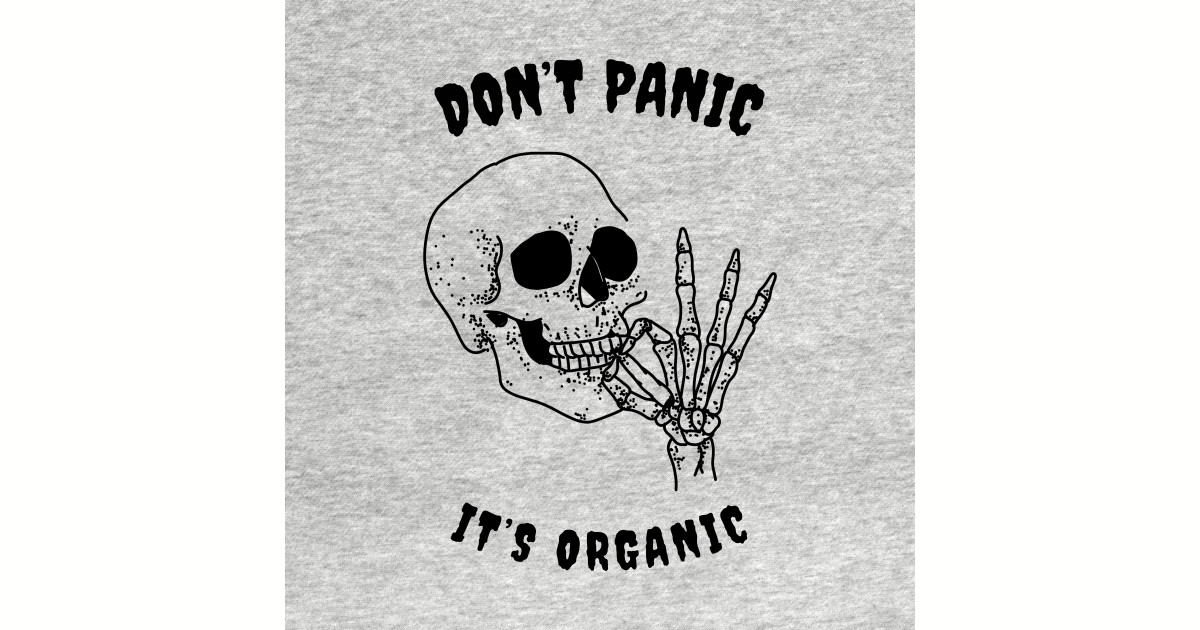Wendy’s and McDonald’s have emerged victorious from a lawsuit that accused the fast food chains of false advertising.
A federal judge dismissed a lawsuit brought against the two companies accusing them of selling smaller hamburgers than advertised and alleging the food didn’t look as appetizing in person as pictured on their websites.
Only because ‘everyone does it’
"US District Judge Hector Gonzalez ruled that Wendy’s and McDonald’s food images “are no different than other companies’ use of visually appealing images to foster positive associations with their products.”
Italics mine
Ahh yes the rarely used “jump off a bridge reversal” defense. If everyone jumped off a bridge would you do it too? Of course!
At the very least I’d start checking for a monster chasing them off the bridge.
“Systemic problems are OK!”
Everyone does drugs, can we stop punishing people for it?
woah woah woah how would we enslave minorities if we decriminalized drugs
be a little more empathetic to slave owners (prisons and by proxy the politicians) please
Not really, that’s a minor part of the opinion. The more important part is they tell you how much food you’re going to get of what kind and then they give you that food. I don’t think anyone would be able to win a case on “my burger didn’t look like the burger in the ad” because every burger looks a little different. Lots of things that are the same don’t look the same and let’s not suddenly pretend we get McDonalds for the appearance. They’d win false advertising if, say, a quarter pounder was only 2 oz.
Lots of things that are the same don’t look the same
…and that’s false advertising, that’s the point of the lawsuit.
yeah this lawsuit is stupid and anyone who thinks McDonald’s would lose is also stupid
have we forgotten what advertising is? its idealized, its artificial, its eye-catching. thats the point. like the suit says everyone does it, thats just good marketing.
frankly i think it makes commericals a bit more tolerable if theyre at least aesthetically pleasing. but marketers marketing in a system that requires advertising for anyone to be relevant cannot be infringed on for just two companies doing the marketing the exact same. blame capitalism for ads not the companies.
(unless we’re taking excessive ads on websites or whatever then blame the sites they’re just greedy)
like the suit says everyone does it
And they should not be allowed to.
what is the line then
how bout this. we ban ALL film. cameras are no longer allowed and any sort of media should be burned as its all idealized and any picture of anything wont look like a picture of something else therefore all media should be banned due to false advertising.
wait that doesnt make any sense. youre not gonna take a shitty video of yourself and post it online youre gonna take a bunch of attempts so it looks better than you actually are. that’s marketing its no different that a company is doing it. therefore if you want to be angry at a company “false advertising” then be mad at every picture in existence too.
try to at least be consistent with your cynicism. dont judge others based on their actions if youre gonna judge yourself only based on your circumstance.
wait that doesnt make any sense.
Well you at least said one sane thing in that rambling cacophony
lol so u dont have any idea and ur just yapping got it
If you replace your underscores with asterisks, emphasis/italics should work as intended.
I am posting this from Voyager, does it not look correct? I did not underscore anything and added the italics for his quote.
Here’s what I see:

Interesting, I do not see the underscores in Voyager.
Interesting indeed
let’s test another theory
This comment is in italics on Voyager
deleted by creator
Holy shit… That’s me making italics with underscores instead of asterisks…
And it shows up right for me in Sync.,
Shit is weird

Nothing in your comment is italicized in Sync.
Does this line show up in italics for you?
Yes it does
GTK…
Lemmy is weird
😂
deleted by creator
It looks fine on Boost for Lemmy
deleted by creator
Imagine a coffee shop ad with a beautiful example of latte art, but when you get your latte you are horrified to find just plain foam. Unless the ad specifically mentioned latte art, I doubt you’d have grounds for a lawsuit.
As for your example, I’m finding it hard to imagine buying a car before getting inside it. A few dealers offer a pre-order option, but you can always back out of the sale once you see the car.
grounds for a lawsuit
There is a joke in there somewhere. ;)
I’m sure you just gotta let it brew for a while. Then the joke will pour right over.
Coffee
America proves once again that we will allow just about anything if it makes corpos money.
Fuckin gonk Corpos
deleted by creator
The advertising angle is likely what sank their case. Proving the food does not meet a technical specification, like not having a quarter pound of beef in a fully cooked patty, is easier to prove. But advertising has always been hyperbole.
A very important aspect that I think people overlook is that they use similar/same marketing photos of the food on their menu. That’s not advertising, maybe that’s what they will argue. If I look at a menu and they have a picture of the food, I’m going to expect I get what I see (within a margin) vs when I see an advertisement I expect it to be a bit hyperbolic.
You could argue that menus are just in-store advertising
A lot of things in stores have to add disclaimers about what is on the cover of the box vs what’s on the inside. I don’t see how fast food gets a pass on that. Or why people are just okay with it too.
Hey I’m not defending them, just trying to imagine what justification they’d use.
Yeah, that might be a good case. Isn’t the weight advertised when it’s frozen/before it’s cooked? How can they call it a quarter pounder if half of it’s weight is reduced before it’s served to you?
Because that’s how food works. You buy a 1lb steak at the butcher and you see him put it on the scale. You don’t weight it when it comes off the grill. You might have added butter to it, and lost some weight to dripping and evaporation. It’s sort of disengenuous, if you have ever cooked, to not understand that they don’t weight cooked patties and throw out the ones that lost too much weight or whatever.
That example doesn’t really translate. The butcher doesn’t cook the meat for you, you take home one pound. If you’re selling cooked meat products, you should have to provide an estimate for the weight of the finished product. One pound of frozen meat is going to weigh a lot less than one pound of thawed meat after it’s cooked
But there’s no way to do that. Should they weigh every patty to be 0.255 lb??
There’s no way to do that? McDonald’s cooks the same burger probably millions of times a day, the patties are cooked for a set amount of time at a certain temperature,they have the process down to a science, and you say there’s no way to do that?
They’re not incentivised to do that maybe. But not “there’s no way to do that.” You can certainly calculate to a small margin how much weight the patty should lose after cooked.
Also they put a * next to the 1/4 pound that explicitly states that it is the patty prior to cooking because this has already been argued in court
The asterisk as I’ve seen is only on advertisements and it’s really only there to shift responsibility away from the retailer towards the consumer. You won’t see that kind of disclosure when you’re there, looking at the menu. I don’t understand the point you’re making though, how is it the consumers responsibility to know that when the consumer can’t verify? I can’t very well inspect the meat and see if you’re calling an iced over pound of meat “1lb” or if it’s thawed, can I? That’s how responsibility is supposed to work. If there isn’t any proof offered, how can the consumer be responsible?
It’s not a surprising result, but advertising now is entirely devolved into straight up lies. Have you seen the techniques they use during advertisements to make food look more appealing? They’re advertising something which is entirely different from the delivered product. Under any kind of logical thinking, that’s immoral and should be illegal. The fact that the current justice system serves corporations more than people doesn’t justify it.
Hurray, they can keep showing us inedible objets d’art in food adverts!
The law favors corporate giants rather than real people? How surprising. Fuck McDonalds and Wendys
I feel a little guilty because while I rarely eat fast food anymore Wendy’s is my favorite
Although fast food is irredeemably trash, Wendy’s really hits the spot sometimes. I’d rather starve than eat a McDonald’s though.
I’ll never understand the Wendy’s fandom. I knew a couple other people who were the same. The only fast food they would eat was Wendy’s. I don’t get it. It’s not like they do anything unique or different from any other fast food restaurant. Please explain yourself.
It’s the fries.
…dipped in the frosty.
I like grilled chicken sandwiches and I just think Wendy’s tastes the best. I eat fast food probably less than half a dozen times a year.
-
quality is better than McD or BK
-
with the biggie bag deal they’re the last affordable option
-
Now, just to add more shit to that sandwich, remember what you said when you read that the Supreme Court has ruled several times that police officers ONLY duty is to uphold the law, and they have no duty or obligation to protect the citizens they police.
“Case dismissed”
The judge said through a mouth full of big mac before banging his gavel and taking a completely unrelated briefcase full of money that the defendants just happened leave around.
That’s an amazing visual
Did anyone really believe the corporate judge would do any differently?
Absolutely not. I remember when this was filled and I thought, “well this will be dismissed soon”
Poor guy now has to take care of a new yacht
“This is so backwards” one would think and then one realizes that all advertising is deception.
The judge tacitly acknowledges this truth.
I dunno, seems like the judge is explicitly acknowledging it.
Just, uh, stop giving these shitty companies your money and uh, problem solved!
Ah yes, if only we did this one easy thing! It so easy!
If it was that easy/simple they would be out of business already. Unfortunately reality doesn’t always line up with these “simple” solutions, as evidence by… reality.
IDK, I stopped going to McDonald’s and Wendy’s: So far it’s going great and their misleading ads no longer affect me.
No. I’m, I’m simply saying that life, uh… finds a way.
The technical term is “puffery”, which the FTC defines as “exaggerations reasonably to be expected of a seller as to the degree of quality of his product, the truth or falsity of which cannot be precisely determined.”
I just recently became aware of that term. Thanks!
they won, we all lost
deleted by creator
I doubt there’s any bribery involved just good old fashioned, “c’mon bro everyone does it”
Legally speaking this is called puffery But that is actually where the case was sorta interesting. Lots of places say they have the best coffee in town, but obviously that’s immposible to determine since tastes differ. So the visual appeal of a burger versus a commercial was always a junk claim.
But a product not meeting the specfic dimensions could be false false advertising. This would certainly apply for lots of other products if they were 10% larger or smaller (like basically anything related to construction). However, the judge here ruled that because the burgers start out as the advertised weight and the process of cooking changes it, then no one is lying.
McDonald’s corporate does all sorts of scummy things. But the judge here absolutely came to the correct conclusion.
Imo pufffery itself should be illegal or at least reined in.
Okay that sounds reasonable. I’ll have to do some digging around. Thanks
I’m honestly confused. Didn’t they show off before that they use the actual ingredients when doing photoshoots? Like no plastic or anything, just making the burger + good lighting, otherwise it’s false advertising?
Of course if you then stick that burger into a tight squished wrapper it won’t look the same, compared to serving it on a plate and setting it up nicely.
I think you’re right I think some of the complaints was the advertisements show more ingredients in the sandwich so they appear larger than they actually are.
Non food items are allowed in commercials but not for the advertised product. The example I heard was Cheerios can use white glue as the milk in a cereal bowl because Cheerios don’t sell milk. I need to look this stuff up more though.
I think one of the things the plaintiff is arguing, which I think is valid, is that the food is not prepared the same way even if the ingredients are the same. The example they use is that the burger patty is browned on the outside but not cooked through, so appears to be a much bigger portion of meat than is actually if the burger. It’s similar to the bait and switch scam of putting all the filling at the top, making it appear the sandwich or burrito is filled with that quantity, but then you open it up and it’s mostly empty.
I think the argument that “we said the exact weight so it’s fine” is BS because few people intuitively understand how much ounces of meat or how many grams a sandwich is, but they can intuitively understand a picture of food.
But then you have to throw the book at literally all of advertising. On TV it shows my chocolate snack bar flying through the air, followed by a trail of shiny milk and a rainbow! And in reality all I get is a boring brown bar lazily sitting in the wrapper. There’s also no penguin holding it for me, darn.
I mean you have all the weights there, you have the calories there and they put the same ingredients into the burgers that they use in the photo shoot. Yes, it might be prepared differently, but who cares? Who seriously expects their food to look exactly like the advertisement, regardless if it’s a burger, a candy bar or whatever?
Sure, they could put photos on the menu that look exactly like what you get. But then you’ll have trouble knowing what’s in the burger (as most ingredients would be hidden) and it would look unappetizing. Nobody wants that.
…and it would look unappetizing. Nobody wants that.
There’s the problem. How about trying to make your food more appetizing. . .
Dude, it’s fast food. It comes delivered in a wrapper or a small box that has been moved around all over the place.
This is not high end eating where they serve you your burger on a proper plate (those ones actually look nice).
Wrong industry.
And if you don’t like it, why the hell would you keep going there?
Who seriously expects their food to look exactly like the advertisement
If that was the case, why are they showing tasty burgers? And not like puppies or boobs or something that will engage more people?
If everyone knows what’s on the screen is not their real food, why does it look suspiciously like their real food only tastier?
I mean, they often do?
Take TV advertisements for the food, there’s often a mascot, actors and other props.
Or look at the menu for a milk shake, you only get a pink or beige or brown liquid, but the menu shows a chocolate bar, fruits or whatever. Nothing you can actually find in the food you then receive.
In 9 out of 10 cases the menu and ads are highly polished up and don’t look like a photo of the real thing.
But they do. They show something that is close to the real thing, but not the real thing. The whole purpose is to deceive.
they often do?
You’re missing the point. In an ad for a burger, why do they put a burger on the screen? Not the burger you’ll actually get, but one that’s similar but tastier looking.
When they’re ALL WRONG they gotta be right right?



















